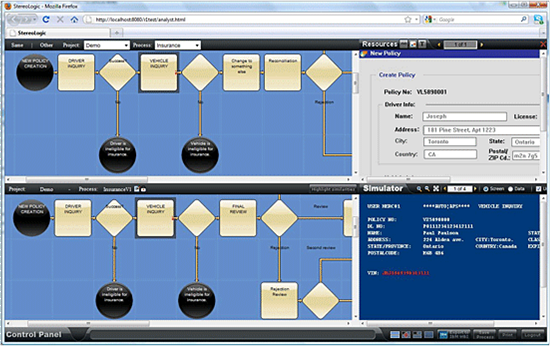StereoLOGIC’s answer to Automatic Business Process Design
Some of you may remember an article I wrote about ABPD in February 2011 (Automating Business Process Discovery). In this article, I introduced a new company to me, StereoLOGIC. I met Sofia Passova, their president and founder recently when she was in London to learn more about the company and their product, Discovery Analyst.
Who are StereoLOGIC? The company was founded in 2008 by Dr. Sofia Passova, Stan Passov and Alex Ladizginsky. All three worked in Blueprint Systems (formerly Sofea Inc.), which specialised in requirements modelling, visualization and simulation. They are a single product company at present. StereoLOGIC offers StereoLOGIC Discovery Analyst. The current customer base is very USA based and includes the States of Arizona, Wyoming, Idaho and North Dakota, who are using it to modernise their Unemployment Tax and Benefit systems, as well as several North American Financial Institutions.
As a small company, StereoLOGIC work through a set of implementation partners; these include IAG Consulting and Sierra Systems. The company is actively looking for partners in Europe at the time of writing.
So what does Discovery Analyst do? The product extracts business processes from business applications in real time to create process models that can be used for visualization and comparison purposes to validate and extend the models and integrated seamlessly with other BPMN-enabled tools.
StereoLOGIC uses its patent-pending semantic recognition software to capture the screen images that are used by an organisation and associates these with process steps and decisions. The software also records what a user has pushed to get to a particular screen, which helps understand and map complex branching logic. An analyst using the tool can associate notes, multiple images, files or technical specs for business rules with process steps. The software assigns the appropriate name to each process step and records the data used on any screen, and associates this with the process step. The process model is produced in standard BPMN format.
Discovery Analyst is designed to capture process flow regardless of the underlying platform. This means as business processes flow from the consumer facing web system, to call centre-facing mid-range AS/400 systems to backend 3270 systems, it can capture the business understanding as it looks to the business as a single continuous set of activities.

Figure 1: StereoLOGIC Discovery Analyst screen shot (Source: StereoLOGIC)
Where organisations have multiple systems operating across different geographies or organisational units that do the same thing, Discovery Analyst can be used to capture both process models and the use functionality in the product to compare the different models.
Discovery Analyst has a dashboard to display performance information about all users and the processes they are working on the application. This allows analysts to spot performance issues, and understand what really happens when users are working with the system, rather than what is supposed to happen.
But why should you be interested in Automatic Process Discovery? Firstly, mapping out the current state of a system is a required part of many modernization initiatives. By radically reducing the amount of stakeholder time needed to conduct this as-is analysis, executives can reduce the total time needed from management stakeholders and internal subject experts—reducing the resource drain in larger initiatives. Secondly, the most challenging part of putting in new modelling tools is getting the model into the tool. This represents as much as 40% of the implementation cost of something like a business process management (BPM) initiative, or even higher in model-driven development. Discovery Analyst comes with an engine for exchanging models with other tools, using industry standard BPMN. Currently, StereoLOGIC also supports direct model export into Microsoft Word, iGrafx and IBM WebSphere Business Modeler for further improvement and transformation. StereoLOGIC also exports process performance metrics for each process activity and the entire process into MS Excel.
ABPD is becoming an important aspect for organisations as they try to get a better understanding of the applications that run their businesses. StereoLOGIC have developed a tool that caters for the vast majority of requirements for the activities needed by analysts and business users. There are two areas that I can see for improvement. Firstly, there is a need to increase the number of interfaces to other major BPMS products. Secondly, I would like to see the ability to capture business rules from the applications and export them to BRMS products.
